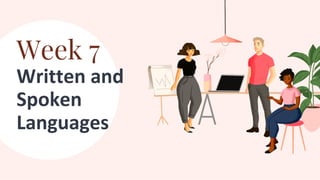
Written and spoken languages with semiotics
- 2. Objectives: A. explore indigenous writing system; B. state the characteristics and structural differences between written and spoken language ; C. Determine the functions and significance of written and spoken language in daily communication. 2
- 3. Language is primarily vocal. Speech was sufficient to meet the communicative and social needs of people who lived in nomadic communities. The Spoken Language
- 4. gradually developed long after speech to serve human needs that the spoken mode could not satisfy. ‘text-as-product’ People’s memory of what happened was no longer enough. The Written Language
- 6. Semitic Alphabet Writing evolved from visual images which had already come into use in settled societies. Indian Cherokee Sequoyah, a North American Cherokee Indian, (c. 1765 – 1843) is the only illiterate person known to have created a writing system. Vai script served purposes in ritual and ceremonies did not last long and were replaced later by Mission and Koranic schools that taught English and Koranic scripts. were for practical record keeping and communication needs while at the same time keeping Vai business enterprises secret 6
- 8. 8 Spoken Language Written Language Speech is universal. Everyone learns to speak a first language in the first few years of life. Not everyone learns to read and write that same language. The spoken language has dialect variations. The written language is expected to conform to a standard form of grammar and spelling Speakers use their voices (pitch, stress, rhythm) and bodies (gestures, facial expressions) to help convey their meanings Writers have to rely solely on the words on the page to express meaning Speakers use pauses and intonation. Writers use punctuation. Speakers pronounce words. Writers spell and write words.
- 9. 9 Spoken Language Written Language Speaking is usually spontaneous and unplanned. Most writing takes time. It is planned. The writer can go back and change what has been written. A speaker speaks to a listener who is right there, nodding or frowning, interrupting or questioning. For the writer, the reader’s response is either delayed or nonexistent. The writer has only one chance to convey information and be interesting and accurate enough to hold the reader’s attention. Speech can have a lot of repetition. The speaker can pause, offer to start again, rephrase without losing the meaning of the utterance. Writing is more formal and compact. It progresses logically with fewer digressions. Speakers use simple sentences connected by a lot of ands and buts. Writers use more complex sentences with connecting words like however, therefore, in addition to.
- 10. Which between the two languages are you more comfortable in using- spoken or written? 10
- 12. Objectives: A. define semiotics; B. identify the proponents of semiotics with their contributions to the study; C. give example of semiotics in everyday living; and D. Recognize semiotics/sign languages as a language of cultural significance to every creature. 12
- 13. SEMIOTICS involves signs, including the production of meaning. can be intentional or unintentional can communicate through any of the senses, visual, auditory, tactile, olfactory, or gustatory references to cultural commonalities (potential for multiple meanings)
- 15. Ferdinand de Saussure Swiss linguist Father of Modern Lingiuistics defined semiotics as the study of “the life of signs within society defined semiotics as the study of “the life of signs within society.” 15
- 16. 16
- 17. - believed that dismantling signs was a real science, for in doing so we come to an empirical understanding of how humans synthesize physical stimuli into words and other abstract concepts - also distinguished parole from langue - Parole refers to the individual language acts which occur when anyone audibly voices letters, words, sentences. Parole is the physical manifestation of speech. - Langue is the abstract system of principles language out of which acts of speech (parole) occur. 17
- 18. Charles Sanders Pierce defined a sign as “something which stands to somebody for something”. demonstrated that a sign can never have a definite meaning, for the meaning must be continuously qualified. distinguished between the interpretant (the internal, mental representation that mediates between the object and its sign) and the interpreter (the human who is creating the interpretant). 18
- 19. 19 - categorize signs into three main types: (1) an icon, which resembles its referent physically (woman and man sign in comfort rooms); (2) an index, which is associated with its referent (leather shoes for men and heels for women); and (3) a symbol, which is related to its referent only by convention and has no resemblance between the signifier and the signified (as with words or traffic signals).
- 20. Charles Morris believed that people are interpreters of signs. - identified 3 stages of human actions that involve signs and meanings : (1) perception stage - the person becomes aware of a sign; (2) manipulation stage - the person interprets the sign and decides how to respond to it; and (3) consummation stage - the person responds. 20
- 21. 21 Stage 1. The actor feels hungry and the hunger serves as a sign. Stage 2. Looks for food, sees the cheese, smells and tastes it. These actions are manipulation for the sign. Stage 3. The actor eats the cheese. Meaning is established by taking hunger as a sign for eating cheese.
- 22. “ FAMILY FEUD English Major Edition 22
- 23. “What are the most commonly used symbols for the term EDUCATION? 23
- 24. What are the most commonly used icon, index or symbol for the term EDUCATION? 24 7 3
- 25. 25 Did you like my powerpoint? I offer some educational services like: -powerpoint presentation maker -grammarian -content creator -layout designer If you are interested, you may email me at flippedchannel27@gmail.com
